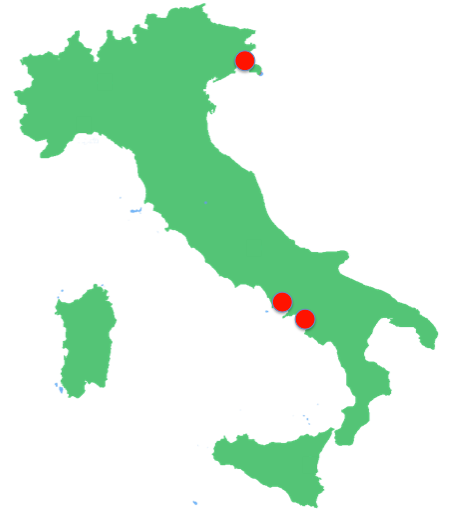Scientific activities of the various Research Units
Napoli
We consider the possibility to construct models beyond GR by taking into account gravitational field theories less restrictive than the one based on the Hilbert-Einstein action and search for their selfconsistent theoretical foundation. These include Extended Theories of Gravity like f(T) teleparallel gravity, where T is the torsion field, f(R,G) gravity, where G is the Gauss-Bonnet topological invariant. We continue investigations on extended theories of gravity in deriving the M-R relation of NS. In particular we focus on analytical and numerical solutions for modified Tolman-Oppenheimer-Volkov (TOV) equations, which describe the super-massive neutron stars, considering some physically relevant extended gravity models, modifying the TOV equations accordingly. Extended theories of gravity predict the existence of additional modes, in addition to the massless spin-two field (the standard graviton of GR). Detecting new gravitational modes could be a crucial experiment able to discriminate among theories, since these modes would constitute evidence that GR must be enlarged or modified. These studies become particularly relevant after the recent discovery of gravitational waves (GWs) by LIGO and VIRGO interferometers. In the absence of a well-based theory to interpret the observations of cosmic acceleration of the Universe, cosmography provides information about the evolution of the universe from measured distances, allowing to select realistic DE models. We plan to perform a high-redshift analysis in order to put constraints on the cosmographic parameters, and obtain indirect constraints on any gravity theory. This analysis is based on the Union2 Type Ia supernovae (SNIa) data set, the Hubble diagram constructed from some Gamma Ray Bursts luminosity distance indicators, and Gaussian priors on the distance from the baryon acoustic oscillations and the Hubble constant In the framework of quantum field theory, we continue our studies of Green functions for a Casimir-type apparatus in different curved backgrounds. We plan to study the consistency of the definition of cosmological tomogram in classical and quantum cosmology, problems related to the quantizer-dequantizer approach to quantum mechanics, and in particular the transition from quantum to classical physics by using the method of gauge theoretical contractions. We continue our studies on the analysis of data coming from the PLANCK experiment and next generation of such experiments, to constrain large-scale structure in extended gravity.Salerno
The CMB radiation picture from the upcoming B-mode polarization experiments (WMAP, PLANCK, BICEP, etc.) is the main source of data about the early universe. Understanding it in terms of gravity wave polarization, density perturbations, and key inflationary observables (power spectrum, spectral index, tensor-to-scalar ratio) is a crucial task. We plan to construct models of extended theory of gravity (focusing in particular on those ones that can be originated by SUGRA), and compute inflationary observables which might be measured in upcoming experiments. Moreover, we plan to continue our studies on baryo/leptogenesis in the framework of (no-scale) SUGRA model. These studies involve gravitino physics, and therefore may serve as the DM candidate. The possibility to interpret SM Higgs as inflaton field, as well as the DM relic density in modified cosmology will be also investigated. A further target of our studies is to investigate aspects related to the fact that higher derivative gravity theories, and more generally, higher-derivative field theories, might be affected by ghosts (i.e. are unphysical), because of the Ostrogradski theorem. Our intent is to investigate extended gravity models that are ghost-free, providing physical selection criteria for admissible higher-derivative field theories. This analysis will be performed by considering both the metric and the Palatini approach. Astrophysical scenarios provide a promising laboratory for constraining, and eventually ruling out, extended theories of gravity. Our purpose is to start the analysis on stellar structures and continue our investigations to constrain, from current astrophysical data, parameters characterizing extended gravity models, with particular attention to physics of GWs. We plan to study quantum effects in curved spacetimes. In particular, we will focus on Casimir-type systems embedded in (modified) gravitational fields and the vacuum energy effects (vacuum condensate) that could play a relevant role in various contexts (e.g., cosmology). The Salerno unit is deeply engaged in gravitational lensing searches (it is the only Italian institute involved in K2-C9, the ninth campaign of the Kepler-2 mission). The purpose is to detect isolated objects (free-floating-planets) within our Galaxy, since, their nature and origin being still unknown, they might contribute to the total amount of DM. We will also study gravitational lensing by BHs and by exotic matter. The aim is to develop a method to express the deflection angle as a function of the BH metric in any class of gravitational theories, so that by measuring higher-order images it is possible to distinguish between GR and other gravitational theories.Trieste
By means of old and newly devised investigation methods of kinematical and photometric data, some of them of our property, to obtain the mass models of always more varied kind of galaxies, as regard their luminosities and Hubble Types. This will allow us to discriminate between then empirical cored and the “predicted” cusped DM profiles in always a large number of objects and to derive, if allowed by DM properties, the profile of the implied diffuse DM annihilation signal. We will investigate the origin of the emerging cored DM distribution, convinced that their phenomenology will lead us to the nature of the DM particle. This could be outside the LCDM paradigm, or even mirror of a new law of gravity. This is very much needed to frame current crucial issues of Cosmology, Astrophysics and Elementary Particles. We continue our studies on Gravitational lensing as a powerful astrophysical and cosmological probe. In particular, we will consider the very valuable range of the submillimeter wavelengths. We will continue with the time-intensive identification of gravitational lenses, involving the shifting of large volumes of imaging or spectroscopic data. We will use data from the Herschel Astrophysical Terahertz Large Area Survey where a thousand of strong gravitational lensing events are detected. These data will allow us to study the statistical and individual properties of dusty star-forming galaxies both cosmologically and concerning their DM content. We plan to determine the mass distribution of stars, gas, and DM present in Galaxies for testing cosmological models of galaxy formation and evolution. For this purpose we map the neutral atomic gas content of Galaxies by using high resolution Very Large Array and Green Bank Telescope observations of the 21 cm HI line emission, deriving the stellar mass surface density map of Galaxy optical disk via pixel-SED fitting methods based on population synthesis models. Moreover, we shed light on the issue of whether the DM is warm or cold, by combining the measurements of the galaxy luminosity functions out to high redshifts, from the Hubble Space Telescope with the recent cosmological data on the reionization history of the Universe of the Planck mission. The aim is to derive robust and tight bounds on the mass of warm DM particles. We also investigate the coevolution of galaxies and hosted supermassive BHs by means of the history of the universe: This exploits a statistical approach based on the continuity equation and the abundance matching technique. We reproduce the local estimates of the BH mass function, the AGN duty cycle as a function of mass and redshift, along with the Eddington ratio function and the fraction of galaxies with given stellar mass hosting an AGN with given Eddington ratio. We plan to exploit the same approach to reconstruct the observed stellar mass function at different redshift from the ultraviolet and far-IR luminosity functions associated with star formation in galaxies. We develop an improved abundance matching technique to link the stellar and BH content of galaxies to the gravitationally dominant DM component. The resulting relation might represent a testbed for models describing the galaxy evolution. Following our previous studies, where we tested two astrophysical objects (Dwarf galaxy Orion and low-luminosity Spiral NGC 3198) by using a power-law f(R) gravity, finding a fit of rotation curves of galaxies much better than LCDM DM halo models, we plan to review this analysis for more generic and admissible models of extended gravity.^ Back to Top


